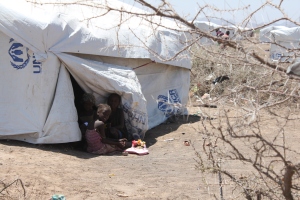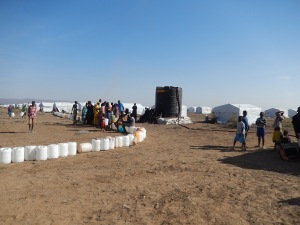The December war crashing from inside Juba – capital city of South Sudan – has resulted in thousands dead and more than 650,000 people displaced.
South Sudan only gained its independence from the Khartoum government two years ago, after a bloody war lasting over two decades. However, the newly recognized young nation has not restored peace even after its independence in July 2011.
President Salva Kiir reshuffled his entire cabinet in July and dismissed his Vice president, Riek Machar. On the 15th December, it was a turning point for Juba when the two rival leaders within the SPLM/A fought over their political difference in governance. The violence erupted as President Kiir accused Mr. Riek of staging a coup plan. The circumstance on how the violence starting was not clear yet.
Since the new tug of war began, there are reports that an unknown number of people, estimated as close to 11,000, have been killed while being sheltered at the UN Mission in South Sudan (UNMISS). The killings quickly turned to be ethnically motivated with clashes between Dinka and Nuer tribes countrywide.
“I barely escaped death, in some towns like Bor and Jonglei people are identified by ritual marks and killed,” Duop Nhial – a South Sudanese Nuer new arrival – told Kanere.
The violent conflict in Juba and other major cities in South Sudan has resulted in more than 650,000 people internally displaced. There have been widespread destruction and extrajudicial killings of thousands of civilians. According to UNOCHA more than 125,000 people are seeking asylum in the neighboring countries of Sudan, Ethiopia, Kenya and Uganda.
“My people killed each other and thousands were killed; it was a sad story to live to tell where many hundreds died and never had funeral or burial,” a South Sudanese widow stated bitterly in an interview.
On January 23rd, a ceasefire agreement was signed between the government and the opposition that should be a commitment to stop fighting, stop attacking civilians and begin a peace dialogue. However, it was not clear enough if the ceasefire was respected. Even after the peace treaty the conflicts have been perpetuated and southerners have kept on fleeing out of that country.
According to UNHCR, the plan was to cater for two scenarios for Kakuma: an influx of 25,000 and 100,000 respectively. “By the end of January about 14,000 refugees have arrived in the camp, in case more than 20,000 refugees arrive the appeal will be revised,” UNHCR Kakuma report indicated.
How the violence impacted Kakuma
Practically speaking Kenya has been a home to thousands of refugees from South Sudan over two decades. From the time it was started to cater for the Lost Boys and Girls of Sudan in 1991, Kakuma has been the largest warehouse that has accommodated majority of its refugees from other neighboring countries across East Africa and the Horn of Africa.
In 2007/8 thousands of South Sudanese repatriated back home following the tripartite commission. However, the lack of democratic government institutions has continued to hinder peace, reconciliation and development. The malfunction of the legal system has led to frequent warfare and conflicts, perpetuating the refugee movement back to Kenya.
Since the war broke out in December, Kakuma has been receiving more than 500 new arrivals on a daily basis throughout the months of January–February. The new arrivals are reaching Kakuma through the Nadapal – Lokichogio entry point that is facilitated by UNHCR. By mid-February, the number of South Sudanese asylum seekers in the camp had rapidly increased to close to 19,000 persons.
Alongside the contingency plan, the local government through the Department of Refugee Affairs and UNHCR has accommodated the new arrivals at a small location in the farthest corner of the camp (Kakuma 4).
Challenges that new arrivals have expressed

At Kakuma, the majority of the new arrivals are unaccompanied minors of which 30 per cent are under five years. These children got separated from their families while on the run for safety.
In what UNHCR describes as lack of adequate funding and logistical challenges, the new arrivals are kept in overcrowded centers lacking proper sanitation for more than three months, as supposedly two to three weeks period. At least two old schools have been used as a new reception point for the new arrivals in Kakuma 3 area.
Lack of enough water adds daily troubles to the living situation for new arrivals and yet the stipulated funding is more than enough to cater for the current influx. The humanitarian NGOs had proposed assistance which is believed to facilitate required provision of essential basic services at the reception centers in Kakuma where new arrivals have access to water, wet feeding and general hygiene.

By the end of December 2013, the population stood at 128,000 according to the camp statistics. Currently, the number stood close below 143,000 and with daily arrivals of refugees the number is expected to reach the maximum holding capacity of 150,000 by the end of February. However, more refugees keep on spilling over to Kakuma.
Thousands of the South Sudanese have had bitter experience where family members were killed in the war. “I was running, stepping on the bodies of the people lying, some are in their last minutes dying. I don’t know what would happen to them,” Chuol Ajak, a Dinka newly arrived southerner, told Kanere.
